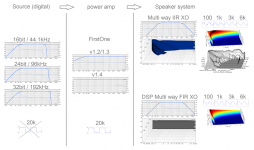Look at the next page of the link 🙂which softstart did you use?
Hello all,
I finished building my dual FO 1.4M. I used dissipante 2U (300mm) chassis and dual audiopower DPS-400/S1-600w smps (+/-52V) and dual UPC1237 speaker protection board.
The addition of "cap-bank" I experimented a lot, best choice for me (the best fast bass) 3.300-4.700uF/rail.
The sound excellent. 🙂
Congratulations, great work LazyCat.
Thanks
Johnny
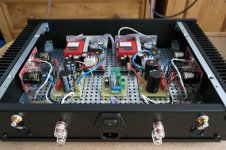
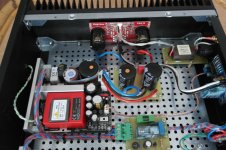
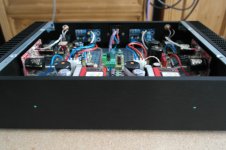
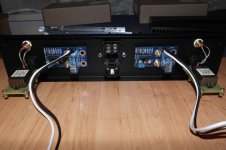
I finished building my dual FO 1.4M. I used dissipante 2U (300mm) chassis and dual audiopower DPS-400/S1-600w smps (+/-52V) and dual UPC1237 speaker protection board.
The addition of "cap-bank" I experimented a lot, best choice for me (the best fast bass) 3.300-4.700uF/rail.
The sound excellent. 🙂
Congratulations, great work LazyCat.
Thanks
Johnny




Hello,
I've been following this thread, although I did not read all posts, as well as the posts of Quebec DIY forum about amplifiers. I also made a DCB1 as many people here.
After this and many other researches, it seams to me that these FO amps have to be in top of my list.
I intend to start with the Medium size. These Mediums are bigger than many big ones out there!
Well, I read about Cresnet smps, Hypex, Audio Power,etc. Adding until 15000uf capacitance with Cresnets is interesting, does it make sense with the Medium modules?
My question is, after all :
What is the best option for the (single end project), Medium boards?
Hypex? Wich one? Cresnet? Wich one? Other? Does it make sense to add a power bank with the mediums? I have a few Supertechs...
Thanks for the help! And thanks for all the information you share here and in other forums too. I fee that soon I will be able to share like many of you, but for now I have to learn a bit more.
I've been following this thread, although I did not read all posts, as well as the posts of Quebec DIY forum about amplifiers. I also made a DCB1 as many people here.
After this and many other researches, it seams to me that these FO amps have to be in top of my list.
I intend to start with the Medium size. These Mediums are bigger than many big ones out there!
Well, I read about Cresnet smps, Hypex, Audio Power,etc. Adding until 15000uf capacitance with Cresnets is interesting, does it make sense with the Medium modules?
My question is, after all :
What is the best option for the (single end project), Medium boards?
Hypex? Wich one? Cresnet? Wich one? Other? Does it make sense to add a power bank with the mediums? I have a few Supertechs...
Thanks for the help! And thanks for all the information you share here and in other forums too. I fee that soon I will be able to share like many of you, but for now I have to learn a bit more.
Increasing Input impedance
I wonder if Charcroft resisters are ok from input to GND. They are 25 kohm.
I wonder if Charcroft resisters are ok from input to GND. They are 25 kohm.
I wonder if Charcroft resisters are ok from input to GND. They are 25 kohm.
Andrej recommends complete ground isolation, so no connection from input to chassis.
On that subject, the RCA input connectors I've bought have plastic washers that will isolate the connector from the front and back of the chassis back panel, but there is nothing to isolate the barrel of the connector that goes through the hole in the chassis back panel. Will it be sufficient if I wrap that part of the barrel with plumbers PTFE tape?
Andrej recommends complete ground isolation, so no connection from input to chassis.
On that subject, the RCA input connectors I've bought have plastic washers that will isolate the connector from the front and back of the chassis back panel, but there is nothing to isolate the barrel of the connector that goes through the hole in the chassis back panel. Will it be sufficient if I wrap that part of the barrel with plumbers PTFE tape?
Usually one of the plastic washers has a small lip which keeps the barrel aligned in a small air gap from the chassis metal. You could use some tape or heatshrink. Check for continuity with a meter to see if you have any connection.
Hello,
I've been following this thread, although I did not read all posts, as well as the posts of Quebec DIY forum about amplifiers. I also made a DCB1 as many people here.
After this and many other researches, it seams to me that these FO amps have to be in top of my list.
I intend to start with the Medium size. These Mediums are bigger than many big ones out there!
Well, I read about Cresnet smps, Hypex, Audio Power,etc. Adding until 15000uf capacitance with Cresnets is interesting, does it make sense with the Medium modules?
My question is, after all :
What is the best option for the (single end project), Medium boards?
Hypex? Wich one? Cresnet? Wich one? Other? Does it make sense to add a power bank with the mediums? I have a few Supertechs...
Thanks for the help! And thanks for all the information you share here and in other forums too. I fee that soon I will be able to share like many of you, but for now I have to learn a bit more.
As you didn't get much response I'll try and give some information.
Cresnet's 600W supply is a good match with the medium modules. Adding large amounts of capacitance can trigger the over current protection, Cresnet doesn't recommend more than 6800uF extra per rail.
Just adding more and more capacitance with an SMPS isn't as easy as a linear supply. Whether you actually need it or not is another question 😉
Andrej recommends the Hypex SMPS1200A400 power supply for the medium modules with 10,000uF extra per rail.
The other difference is the voltage that the supplies use, Hypex A400 is 63V and Cresnet's 600W were 55V, although he might be offering different voltages now.
As to which is better I imagine you would would get many different answers I don't know that anyone one person has tried them all in any kind of controlled test to give you a better answer.
Cresnet's supplies are quite a bit cheaper than the Hypex and I think use better quality components. They are more compact and Cresnet is very helpful if there is an issue.
There have been some quality control issues with the Hypex supplies before maybe they are fixed now. I had to send one of my supplies back to Hypex to be fixed. They are a good company and fixed it without issue but it cost me more in postage to send it back than it did to buy one of Cresnet's supplies. Maybe not an issue for you in France.
I have no idea what you mean by a powerbank or Supertechs.
Andrej recommends complete ground isolation, so no connection from input to chassis.
On that subject, the RCA input connectors I've bought have plastic washers that will isolate the connector from the front and back of the chassis back panel, but there is nothing to isolate the barrel of the connector that goes through the hole in the chassis back panel. Will it be sufficient if I wrap that part of the barrel with plumbers PTFE tape?
No I just want to replace the 10 kohm resistors on PCB with the 25 kohm Charcroft. Up to 25 is ok LC wrote. My problem is the way Charcroft is made. It is one very long Copper trace inside the resistor. I am thinking oscillation etc.
Sami, send me a mail regarding price@Fluid
Some stock is available now for +-60.5VDC
Good points fluid,
Look forward hear more when your current XO-less speakers build get finished and feeded from FO amp, chances should be FO in theory by far outperform domain before and after : )
Very true Byrtt, a well designed amplifier is never the weak link in an audio chain. It is almost always the speakers that are the most defective part!
Much easier to change the cables, DAC amp etc........
I will feel better when I have been able to get some measurements of my FO builds to confirm that all is well THD and frequency response wise.
Studley, you would have to find a bulb which does not start lighting while passing the FO iddle current (280ma) thats a challenge.
benefit of the bulb is mainly to avoid burning something and showing a potential problem like deep oscillation or failure in the cabling (or for example if you forget the heatsink isolator).
As the FO is already fully tunned and tested in factory this is from my point of view not needed if you double check all your wiring. I would recomend a fuse instead (on each rail).
benefit of the bulb is mainly to avoid burning something and showing a potential problem like deep oscillation or failure in the cabling (or for example if you forget the heatsink isolator).
As the FO is already fully tunned and tested in factory this is from my point of view not needed if you double check all your wiring. I would recomend a fuse instead (on each rail).
Ok thanks for the advice. I also have a variac so will use that on start up.
A variac is a man's best friend.

Every home should have one. 😀
(and a scope)
Trim pots
I am having difficulty adjusting the idle current and DC offset. How sensitive are the trimmers? Are we talking multiple revolutions to get an effect?
I am having difficulty adjusting the idle current and DC offset. How sensitive are the trimmers? Are we talking multiple revolutions to get an effect?
1/4 turn, then cross check with voltmeter, eventually let the system 2 minutes before controling as this change has to be reflected on the heatsink and to stabilize.
Then repeat process until convergence is observed.
When You turn in the other direction then mecanically there is a gap an the value may not change so 1/2 turn might be needed
Then repeat process until convergence is observed.
When You turn in the other direction then mecanically there is a gap an the value may not change so 1/2 turn might be needed
Last edited:
I am having difficulty adjusting the idle current and DC offset. How sensitive are the trimmers? Are we talking multiple revolutions to get an effect?
It depends on how far off the target you are to some extent, different supply voltages can make the factory setting not that close so you might need to turn more.
If you carefully read the instructions it tells you which way to turn the trimmers to have the effect you want. There is usually only one direction on one trimmer that will have the overall effect you want.
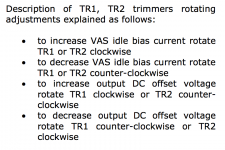
E.g. If you want increase bias and decrease DC offset turn TR2 clockwise
It is a balancing act and can be quite frustrating unless you have three meters to watch at the same time.
I found with only two it was easier to leave one connected to measure overall current as an ammeter and then use the leads of the other to check between the vas and dc settings.
When I first started I tried to set one parameter how I wanted and then get the other but it doesn't work like that as the parameters are interactive

It went much faster when I actually read the instructions more closely as I then knew which way to turn the trimmers to get what I wanted 😉
- Home
- Vendor's Bazaar
- First One - mosFET amplifier module
